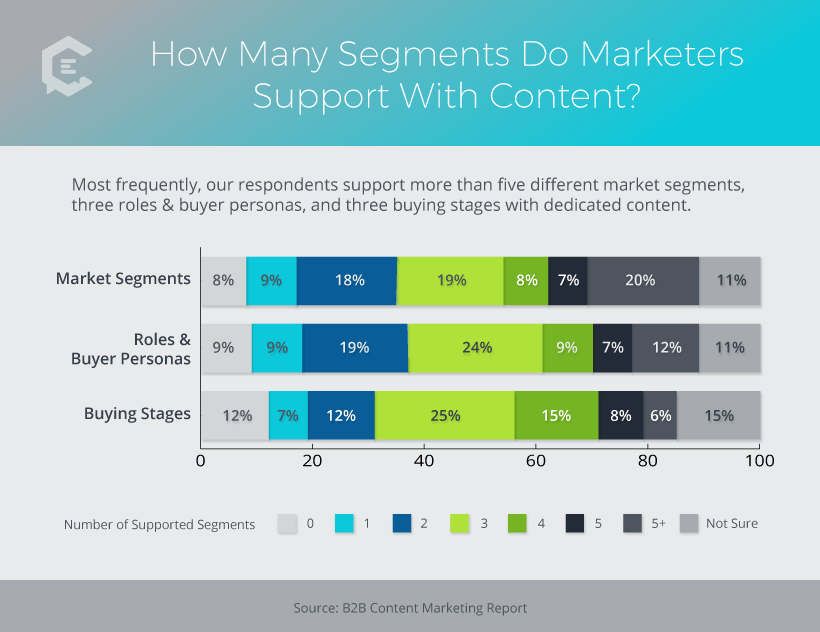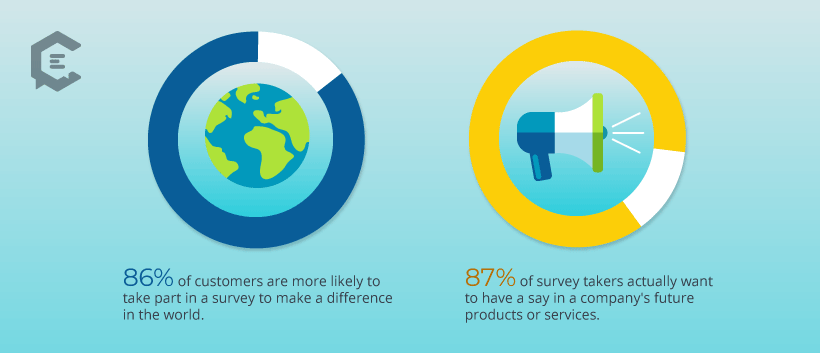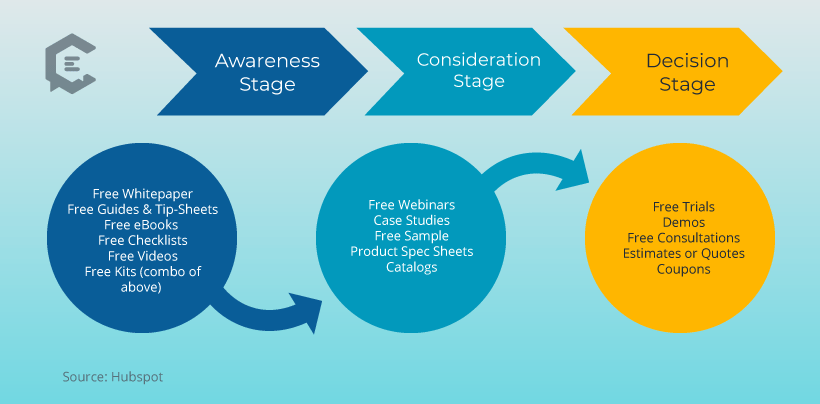When you consider the mass of customers who buy your products or select your services, how do you perceive them? Maybe you picture your customers as a sort of blurry amalgam; you have a general idea of who they are, but no clear image of what makes them special or different from each other. You keep tossing content at them, wondering when something will really speak to your audience. When a piece of content is successful, you’re excited — but you’re not really sure why it worked or how to replicate the effect with future content.
Dividing up your customers into distinct segments makes it possible to target your content more effectively. You won’t be wasting time and effort on generalized content. You’ll be able to distinctly identify the values and dreams of a specific market segment and show them why your product matters for their lives.
According to the B2B Content Marketing Report, 71% of marketers support two or more roles and buyer personas with dedicated content. And MailChimp claims that segmented email campaigns have a 14.31% higher open rate then non-segmented campaigns. If you segment by interest groups, you’ll get about 10% more opens and 74.53% more clicks than non-segmented campaigns. In this article, I’ll show you how to segment your customer base and extend your content marketing reach as a result.

Identify the differences
How easily can you identify distinct groups or segments within your broader consumer base? Take a closer look at who your customers really are.
By demographics
One way to divide up your customers is by demographic variables, such as income, age, ethnicity, marital status, and occupation. If you’re providing a cleaning service, for example, you may be able to divide your customers up like this:
- Seniors who are unable to clean their homes effectively due to physical frailty (regular customers)
- Young working mothers who are stressed and overwhelmed (occasional customers)
- Successful professionals who own large, beautiful homes and have plenty of money to pay for the best housekeeping services (frequent customers)
To capture meaningful and useful demographic data, I recommend you solicit survey-based feedback from your audience. Copywriter and ad consultant, Marc Schenker, explains the value of collecting demographic data for content marketing, “Surveys of your customers, audience, and target demographics give you the insight and data necessary to put together content that speaks in relevant terms to them.”
Asking your audience to participate in a survey, if done tactfully, is also a fantastic way of endearing them to your brand. In fact, a greater percentage of people say that taking a survey to have a say in a company’s future product or service offering is more important to them than taking a survey to make a difference in the world.
By other variables
Demographics aren’t the only variables, of course. You can split up your customer groups by geographic variables like ZIP code, climate or region. For instance, a company selling landscaping supplies would need to segment by region or climate, due to the different needs of cold-weather areas vs. warmer areas. It’s also possible to divide customers into groups based on psychographic variables (interests, political orientation, or activities) or by behavioral variables (new customers vs. repeat customers; buying habits, etc.).

Craft the new segments
Based on the differentiating factors that you’ve found, you should be able to split up your customers into separate categories, without much overlap. Don’t go too deep with the segmentation, or you’ll end up with too many tiny segments. The idea is to divide your customer pie into large wedges, not a myriad of tiny slices.
Make sure that your segments are stable, as well. Will a customer remain in this particular segment for months or years? Will you always have customers who fit the parameters of the segment? If a particular segment seems like a moving target, perhaps you can find a new way to divide your customers into groups, so you’re not wasting your efforts on a group that may not exist in a year or two.
As you assign your customers to their respective segments, determine how reachable those segments are. Does your company have the resources it needs to connect with those people right now? If not, you may need to invest in some fresh martech tools or create a social media channel to connect with individuals within a specific segment.
Creating targeted content
Now you need to adjust your content strategy. As daunting as it may sound, it’s important to meet with your content marketing team, re-train your writers, and refocus your message and vision for each new customer segment.
For an example, let’s go back to the idea of a residential cleaning business. When you’re talking to the wealthy professionals with large homes, you might emphasize luxury cleaning packages and your employees’ attention to detail. You might blog about the proper care and cleaning of fine furniture and the different ways to maintain the beauty and quality of a home’s interior. For the senior customers, you might leverage content related to travel, retirement, relaxation, health and family. For the young working mothers who don’t always have time to clean, emphasize your time-saving services and focus on other content that promotes work-life balance.
Here’s another way to look at it. No matter what product or service you sell, you can design content for four specific categories of buyers.
- For potential customers, offer high-interest content with a lighter tone and general information.
- For new customers, introduce them to your company and offer helpful information and tips.
- For experts on your type of product or service, focus on convincing and converting them with thoroughly researched information and plenty of details.
- For insiders, use self-promoting content and help them feel like part of a club; give them the inside scoop on every new product or option.
Work with your writers and other content creators to define clear content parameters and goals for each customer segment you’ve identified.
Creating sales-funnel-specific content is another important step in ensuring your content is going to be well targeted, not only to a specific category of buyer but also to those buyers in specific stages of evaluating your product. While there is a full discussion that could be had on marketing and sales funnels, to put it briefly, you should be creating content that resonates with your potential buyer each step of the way, from awareness, to consideration, and then to the sale.
Diagram source: HubSpot
Handling business-to-business segmentation and content marketing
If you’re in the B2B realm rather than dealing with individual consumers, your approach to segmentation will need to be a little different. You can use similar geographic variables to create market segments, or you can differentiate by company size, industry, company policy, buying habits, or urgency. Who makes the decisions for these businesses? Are there certain policies or needs that make some of your B2B customers special?
Remember, buyers or influencers at a business may have little time to “listen” to your content, and they might be feeling pressure from stakeholders or board members. Keep your content for them succinct and clear across the board. When you personalize the content for each segment, focus on the concrete benefits for that specific group of businesses. Are you selling continuity planning software? Your content marketing will differ for educational institutions vs. banks, or for manufacturing facilities vs. grocery store chains. Design content that speaks to each business’s unique needs.
Until now, you might have been speaking to all your customers in the same way, regardless of their differences. Your messaging had to be general enough to apply to all of them; and because of that necessary vagueness, your content marketing was less effective. Once you split up your customers into segments, you can tailor your content marketing to each segment as its own unique audience. That’s a recipe for more powerful customer connections, greater shareability for your content, and expansion of your marketing horizons.




